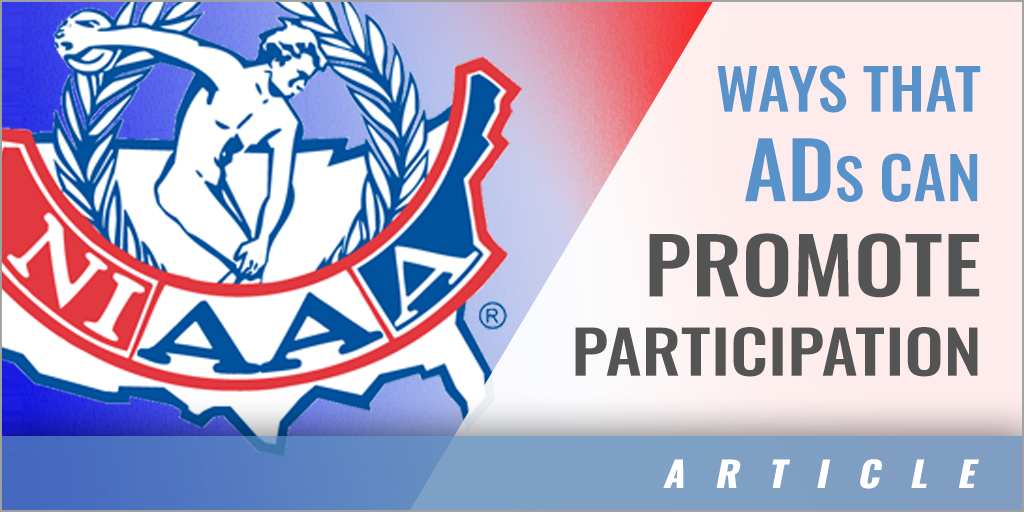|
By: Kevin Bryant, CMAA and John Gray, CAA Participation in high school athletics is on the decline for the first time in 30 years. If we want to stem this tide, we must do several things. We must begin by taking seriously our responsibility to live out educational-based athletics in practical ways. We often talk about this topic like we are all on the same page and heads all bob up and down in agreement. However, we lack the will, understanding, and thoughtfulness to make sure it happens. We must be intentional in our approach. We can discuss high school athletics as another "classroom," as a "co-curricular enterprise" but high school athletics will be just that only is if IT TRULY IS! Saying something does not make it so. We need to be direct and practical to parents and student-athletes as to our "guarantee" of what this "educational-based" athletic program will give them. There are several reasons for this downturn in interscholastic athletic participation including: too much of a commitment is required to participate; students are used to short-term commitments and immediate rewards; preparing for tryouts, weightlifting and running; summer league and out-of-season workouts are not activities that draw people to commitment anymore. The overreliance on technology has given many young people a dependence on quick answers-point and click action does not lend itself to preparation, physical challenge, and patience. Fun is missing from participation in sport. Students are not finding enjoyment and meaning in participation. It has become a chore and lacks personal connection to this powerful medium of sport. Some students do not participate because they are afraid of failure. Trying something new, unfamiliar, and challenging makes it easier to let those opportunities slide by, or to withdraw from them when they become too difficult. Many teenagers today have crazy lives and often have a family that is in crisis, members are missing, or they are just plain busy. Students are working for college savings, for car payments, taking care of siblings after school or getting their first two years of college done while completing their high school degrees. The traditional high school athletic environment does not appeal to them when other important life stuff is going on around them. Some do not participate any longer because they are tired of coaches "chewing them out all the time." The adults coaching them have not connected with them on a personal level and as a result, the sport experience has taken on less meaning. They are officially burned out on sport. Current estimates are that 70% of students end their playing careers by age 13. Overly ambitious parent expectations and constant pushing have led others to opt out of what they consider the athletic rat race. Some continue playing, but for AAU/Club teams whose standards of expected on and off field behavior, academic expectations, and lack of school commitment are winning the day. Some lack the purpose, passion, energy, and joy of playing with their classmates on a school team. Whatever the reason or motivation for a disconnect, students are deciding to forgo participation in record numbers. Before taking the text above too seriously and shutting down high school athletics around the United States, we must rebound by seeing the glass as half full and focus on why more high school students have chosen to participate at this point than at any time in the history of high school sport. Fun is the reason most often given by students for participating in sport in the high school environment. Fun consists of being with friends; fun representing their school and fun during the competition, challenge and improvement needed to be their best. Friends is clearly the 2nd most important reason that students give for their participation. Relationships and making memories that last a lifetime is also a critical element of a successful high school athletic experience. A passionate love of the game is another reason that students participate in high school sport. The joy of playing the game, a perfect pass off a fast break for a lay-in, the turning of a double play, an overhead put away off a lob in tennis doubles, a perfect spiral for a touchdown, and a match winning spike in volleyball all bring joy to the participants as well as those watching. Competition was originally a concept that centered around each person giving their best to make the person they were competing against give their very best. This is a prime value of high school sport, the challenge to be your best and bring that out in those you compete against. If there were ever a time when we needed to challenge our students to be involved in something bigger than themselves, high school sports can come to the rescue. Our students are asked to consider others equal to themselves, give themselves up for their teammates, sacrifice and be involved in something bigger than themselves. There is a life lesson that makes a lifetime impact. Every teenager needs an adult, not just a parent, who believes in them, connects with them and truly loves them and wants their best. High school coaches and teachers do this every day which is why students stay in sport, which, in turn, is a powerful recruiting tool for those considering taking part. As was shared with athletic directors at the 2019 NIAAA/NFHS national conference in Baltimore, Maryland, there are several ways in which athletic directors can impact student participation in their school and community.
If we want to grow our athletic programs, we must commit ourselves to learning, as painful as that reality might be. Are we teachable? Do we want the best for our student-athletes? The previous mentioned ideas are not magic, but they contain some truth for holding on to our current athletes and attracting new participants. As coaches and athletic directors, our best efforts to involve students to participate will result in lifetime impact and lives changed. Let us renew ourselves in giving our best to see this take place!! |






